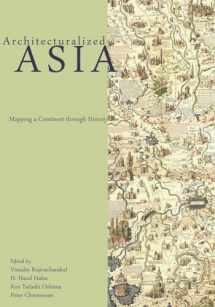
Architecturalized Asia: Mapping a Continent through History (Spatial Habitus: Making and Meaning in Asia's Architecture)
ISBN-13:
9780824839529
ISBN-10:
0824839528
Edition:
Illustrated
Author:
Ken Tadashi Oshima, Peter Christensen, Vimalin Rujivacharakul, H. Hazel Hahn
Publication date:
2014
Publisher:
University of Hawaii Press
Format:
Hardcover
344 pages
Category:
Criticism
,
Architecture
,
History
,
Regional
,
Asian History
FREE US shipping
Book details
ISBN-13:
9780824839529
ISBN-10:
0824839528
Edition:
Illustrated
Author:
Ken Tadashi Oshima, Peter Christensen, Vimalin Rujivacharakul, H. Hazel Hahn
Publication date:
2014
Publisher:
University of Hawaii Press
Format:
Hardcover
344 pages
Category:
Criticism
,
Architecture
,
History
,
Regional
,
Asian History
Summary
Architecturalized Asia: Mapping a Continent through History (Spatial Habitus: Making and Meaning in Asia's Architecture) (ISBN-13: 9780824839529 and ISBN-10: 0824839528), written by authors
Ken Tadashi Oshima, Peter Christensen, Vimalin Rujivacharakul, H. Hazel Hahn, was published by University of Hawaii Press in 2014.
With an overall rating of 3.9 stars, it's a notable title among other
Criticism
(Architecture, History, Regional, Asian History) books. You can easily purchase or rent Architecturalized Asia: Mapping a Continent through History (Spatial Habitus: Making and Meaning in Asia's Architecture) (Hardcover) from BooksRun,
along with many other new and used
Criticism
books
and textbooks.
And, if you're looking to sell your copy, our current buyback offer is $0.7.
Description
This collection explores built environments and visual narratives in Asia via cartography, icons and symbols in different historical settings. It grows out of a three-year project focusing on cultural exchange in the making of Asia’s boundaries as well as its architectural styles and achievements. The editors―architectural scholars at University of Delaware, Seattle University, University of Washington and Harvard University, respectively―attracted contributions from Asia, Europe, and North America. The manuscript consists of three sections―in Mapping Asia: Architectural Symbols from Medieval to Early Modern Periods, authors examine icons and symbols in maps and textual descriptions and other early evidence about Asian architecture. Incorporating archival materials from Asia and Europe, the essays present views of Asian architecture seen from those who lived on the continent, those who saw themselves residing along the margins, and those who identified themselves as outsiders. The second section, Conjugating Asia: The Long-Nineteenth Century and its Impetus, explores the construction of the field of Asian architecture and the political imagination of Asian built environments in the nineteenth century. It discusses the parallel narratives of colonialism and Orientalism in the construction of Asia and its architectural environment, mapping how empire-expanding influences from Europe and North America have defined “Asia” and its regions through new vocabularies and concepts, which include, among others, “Eurasia,” “Jap-Alaska,” “Asie coloniale,” “the Orient,” and “Further India.” The third section, Manifesting Asia: Building the Continent with Architecture, addresses the physical realization of “Asian” geographic ideas within a set of specific local and regional contexts in the twentieth century. It examines tangible constructions as legible documents of these notional constructions of Asia, and discusses their construction processes, materials and critical receptions as evidence of the physical's reciprocal relationship to the conceptual. Regions and conditions covered include French Indochina, Iran, post-Soviet Central Asia, Japanese landscape, and the construction of the Afro-Asian built environment.


We would LOVE it if you could help us and other readers by reviewing the book
Book review

Congratulations! We have received your book review.
{user}
{createdAt}
by {truncated_author}


